I’ve just received the first samples of the Darjeeling spring teas, or “first flush”. The buds on the plants are very small, and the shoots are still a little slow due to the generally cool winter. The temperature is still too low to allow an abundant crop. Nonetheless, certain planters have produced some wonderful teas.
I’ve just bought the first tea of the year – a very small lot of just 15kg – from the Teesta Valley Tea Estate. This is a lovely plucking, with leaves just lightly rolled, giving a fresh infusion that is both vegetal and fruity, and a supple liquor with pronounced vegetal and almond notes. A pure delight.
To accompany your tea tasting, here is a view of the Teesta Valley Estate itself. It offers the same roundness and sweetness as well as the famous vegetal note… It’s as if the landscape itself was reflected in our cups.










